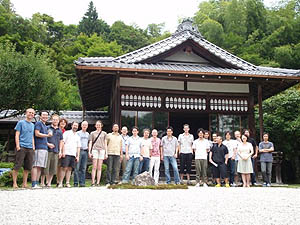JSPS Fellow's Experiences in Japan
Ms. Marieke Rohde(Sussex University)
*The relation between mechanism and function in neural robot controllers: Comparing evolved and explicitly designed networks using an associative learning task.*
The efficient and helpful attitude of the JSPS and particularly of my host laboratory (the Complex Systems and Artificial Life Laboratory at the University of Tokyo, headed by Prof. Takashi Ikegami) made it possible for the short term (three months) research stay to be very productive.
As planned, I conducted a simulation experiment on open-ended robot learning that followed up to a project that formed part of my D.Phil. (cf. Rohde, M. 2008), using the facilities and support at my host research group (publication of the results still in preparation). I investigated the strategies and performance levels of simulated evolved agents to adapt to changes in their environment through embodied mechanisms of associative learning.
A project that relates to this work was the co-organisation of an international workshop on agency in natural and artificial systems with my host, Prof. Ikegami, Prof. Tani from Riken Brain Science Institute and Dr. Di Paolo from the University of Sussex, my previous D.Phil. supervisor. The workshop took place the 11.07.-12.07.2008 in Kyoto and we, the organisers, are currently editing a special issue of the journal Adaptive Behavior to publish the workshop outcomes. (Workshop webpage: http://sacral.c.u-tokyo.ac.jp/kaw2008/ )
I also started an ongoing collaboration during my stay there on using evolutionary search techniques, which is my area of expertise, to parameterise a particular type of neural network controllers (FitzHugh-Nagumo neurons) for dancing behaviour in an autonomous wheeled robot. This research is an extension of previous work at my host group (e.g., Aucouturier, Ogai & Ikegami, 2007) in which the complex dynamical properties of the this type of controller are exploited in order to bring about interesting and variable rhythmic dance patterns, marked by phases of coupling and decoupling, just as human dancing, and are therefore more interesting and pleasant to the human consumer. This collaboration is continued despite the end of my placement in Tokyo.
With such a short research stay, it is always the danger that the double relocation (moving there, moving away, getting used to the group) delays progress on a project or, in the worst case, stands in the way of its completion. Due to the courteous, efficient and organised nature of Japanese society, the open, non-bureaucratic and supportive climate at my host research group and the help of the JSPS this was not the case for this research project, for which I am very grateful.
References: - Aucouturier, J.-J., Ogai, Y. and Ikegami, T. (2007): Making a robot dance to music using chaotic itinerancy in a network of FitzHugh-Nagumo neurons. Proceedings of the 14th International Conference on Neural Information Processing (ICONIP), Kitakyushu, Japan, Nov. 2007 - Rohde, M. (2008): Evolutionary Robotics Simulation Models in the Study of Human Behaviour and Cognition. D.Phil. Dissertation, 04.2008 Department of Informatics, University of Sussex.






